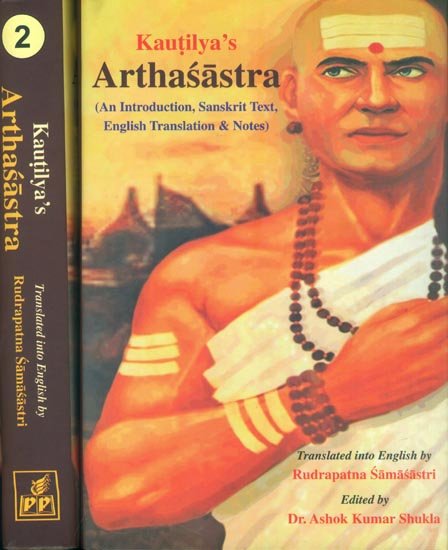Kautilya Arthashastra
by R. Shamasastry | 1956 | 174,809 words | ISBN-13: 9788171106417
The English translation of Arthashastra, which ascribes itself to the famous Brahman Kautilya (also named Vishnugupta and Chanakya) and dates from the period 321-296 B.C. The topics of the text include internal and foreign affairs, civil, military, commercial, fiscal, judicial, tables of weights, measures of length and divisions of time. Original ...
Chapter 18 - A Prince kept under Restraint
[Sanskrit text for this chapter is available]
Summary: The Conduct of a Prince kept under Restraint and the Treatment of a Restrained Prince.
A prince, though put to troubles and employed in an unequal task shall yet faithfully follow his father unless that task costs his life, enrages the people, or causes any other serious calamities. If he is employed in a good or meritorious work, he shall try to win the good graces of the superintendent of that work, carry the work to a profitable end beyond expectation, and present his father with the proportional profit derived from that work as well as with the excessive profit due to his skill. If the king is not still pleased with him and shows undue partiality to another prince and other wives, he may request the king to permit him for a forest-life.
Or if he apprehends imprisonment or death, he may seek refuge under a neighbouring king who is known to be righteous, charitable, truthful, and not given to cunning, but also welcomes and respects guests of good character. [36] Residing therein he may provide himself with men and money, contract marriage-connection with influential personages, and not only make alliance with wild tribes, but win over the parties (in his father’s state).
Or moving alone, he may earn his livelihood by working in gold mines or ruby mines or by manufacturing gold and silver ornaments, or any other commercial commodities. Having acquired close intimacy with heretics (pāṣaṇḍa), rich widows, or merchants carrying on ocean traffic, he may, by making use of poison (madanarasa), rob them of their wealth as well as the wealth of gods, unless the latter is enjoyable by Brāhmans learned in the Vedas. Or he may adopt such measures[1] as are employed to capture the villages of a foreign king. Or he may proceed (against his father) with the help of the servants of his mother.
Or having disguised himself as a painter, a carpenter, a court-bard, a physician, a buffoon, or a heretic, and assisted by spies under similar disguise, he may, when opportunity affords itself, present himself armed with weapons and poison before the king, and address him:—
“I am the heir-apparent; it does not become thee to enjoy the state alone when it is enjoyable by both of us, or when others justly desire such enjoyment; I ought not to be kept away by awarding an allowance of double the subsistence and salary.”
These are the measures that a prince kept under restraint has to take.
Spies or his mother, natural or adoptive, may reconcile an heir-apparent under restraint and bring him to the court.
Or secret emissaries armed with weapons and poison may kill an abandoned prince. If he is not abandoned, he may be caught hold of at night by employing women equal to the occasion, or by making use of liquor, or on the occasion of hunting, and brought back (to the court).
When thus brought back, he shall be conciliated by the king with promise of sovereignty “after me” (i.e. after the king’s death), and kept under guard in a definite locality. Or if the king has many sons, an unruly prince may be banished.[2]
[Thus ends Chapter XVIII, “The Conduct of a Prince kept under Restraint and the Treatment of a Restrained Prince,” in Book I, “Concerning Discipline” of the Arthaśāstra of Kauṭilya.]
Footnotes and references:
[1]:
These measures are treated of in Book XIII. See the contents, Chapter I of Book I.
[2]:
In śloka-metre.
